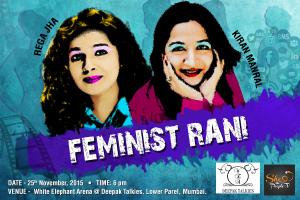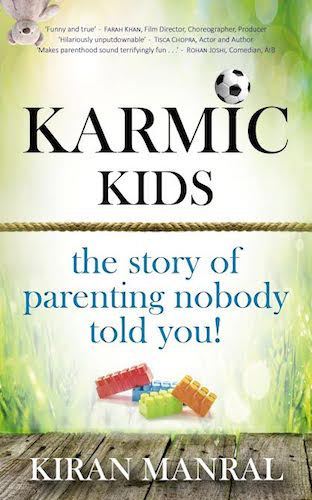Kiran Manral's Blog, page 37
November 23, 2015
A weekend away at Le Meridien, Mahabaleshwar #DestinationUnlocked
The good people from Le Meridien called in the middle of last week. Would I like to go to check out their property in Mahabaleshwar, they asked. Given that I’d spent the better part of the past two months travelling in and out of the city for various book related events, the last thing I really wanted to do was travel. But the offspring had been whining incessantly about how it was not fair, and how he was stuck at home while I travelled all over the place. And perhaps this would be a good break for him before school reopened and he got back into the grind. And so I accepted.
He packed his own bag, one with his clothes and a smaller one, for his toys. His WWE action figures. “In case I get boredt.”

We set off on Friday morning at the crack of dawn from Mumbai, the pitstop at Lonavala food court to refuel had me cautioning him to stick to the idli sambar given I knew his propensity to become a projectile hurling device when confronted with mountain roads. When we finally reached Le Meridien Mahabaleshwar, in an Avomine induced sleep haze (the offspring’s, not mine) the hunger pangs were striking, and striking hard at that.

The first thought as we turned in from the road into the neatly paved path leading to the reception was the number of buggies that were parked along. So many buggies, asked the offspring. Bud wai? We would soon find out, we realised. A smooth check in later, we were directly off to the restaurant Latest Recipe for lunch. Latest Recipe and the Indian dining restaurant, Chingari, are situated in a building a little away from the reception, reached by an imposing stairway. The best thing about the stairway I realised, is that it has been thoughtfully designed, so part of the stairs morph cleverly into a zig zag ramp way for either prams or wheelchairs, enabling access to everyone.


The cafe, cheerful done up in white and pastels, had interesting steel thermos flasks set in niches in the wall, wall murals of plated settings, mixed seating that ranged from six seaters to intimate armchair seatings for two and three, was just what hungry souls wanted after a long drive.

The offspring discovered on offer his personal all time favourite Rogan Gosht and having confirmed plain steamed rice was available, he got down to the task of dingle handedly demolishing the contents of the chafing dishes.
After lunch, we discovered exactly why those buggies were so omnipresent, we needed them to get around in the property, because all the food we’d just eaten had put us into a complete food coma.



Villa 5 was ours, a lovely room done in greys and purple and metallics, with a lovely little sitout shaded by trees, looking onto a path. The bathroom had a huge bathtub and that was invitation enough for the offspring, who has to normally be sent in for his daily bath at gunpoint to state that he was very dirty after the journey and needed a proper bath.



Post which, we were off to High Tea where Brian Povinelli, Global Bran Leader for Le Meridien and Westin Hotels and resorts spoke about the ethos of the brand world and their expansion in this region. “Families are somewhat forgotten in this industry,” he said, “What we wanted to create is a multigenerational experience, where the entire family can find something to interest them.” Their programme is called #DestinationUnlocked, that aims at helping an entire family holiday together, and discover a destination. All their properties are based on the basic premise that people want to feel that they’ve been somewhere. Elements of the local culture find their way into every element of the hotels designed, whether through the decor, the cuisine or the various elements that make up the property. For instance, at Le Meridien, Mahabaleshwar, the ubiquitious local strawberry finds its way into the dessert tray, the signature éclairs and even into light crisp sandwiches.




A tour of the property was called for and we went walking through the infinite paths that comprised the property, stopping to see the little touches at the corners, a thoughtful gnome in a garden somewhere, a man sitting on the stairs at another.


The evening was a lovely sit down dinner at the Henry Lawns, with Samantha Edwards performing some fabulous jazz vocals. The nip in the air was just right to be pleasant without being chilly. The next morning, after a lovely breakfast, we set off again to explore the property. We discovered the Kids Club, where the offspring had a blast.

The Kahaani festival was also on, with storytelling workshops by children’s authors Shabnam Minwalla and Jerry Pinto and a theatre session for children by Tom Alter which had the offspring quite enchanted. There was puppetry, dance, music, baking and what have you to keep the offspring completely busy –allowing me to take time out for a Swedish massage at the Explore Spa. An hour long massage with a blend of rose and lavender had me relaxed, refreshed and completely de-stressed.
 There was also strawberry picking at a strawberry farm, a visit to an artists’ village, Devrai which made the most divine brass and wood artefacts, and a visit to an ancient temple.
There was also strawberry picking at a strawberry farm, a visit to an artists’ village, Devrai which made the most divine brass and wood artefacts, and a visit to an ancient temple.  Dinner that night was at the Indian restaurant, Chingari, which had the offspring completely bowled over by their mutton biryani and the seekh kababs which he declared were the best he’d ever tasted, and trust me he’s tasted a lot of them.
Dinner that night was at the Indian restaurant, Chingari, which had the offspring completely bowled over by their mutton biryani and the seekh kababs which he declared were the best he’d ever tasted, and trust me he’s tasted a lot of them.





We left the next morning, most reluctantly. In fact, the child was insistent he would stay back, all I needed to do was to leave my debit card behind with him. But alas, school was reopening the next day and he was led away, very very reluctantly from the resort, promising himself he would come back again, and very soon at that.
Thank you Le Meridien, Mahabaleshwar, for a lovely weekend.
(Disclaimer: We visited this property on invitation from Le Meridien)


November 22, 2015
My iDiva Column this week: Why Should We Talk to Our Children About Terrorist Attacks
By Kiran Manral | posted Nov 20th 2015 at 1:44PM

“Will the Paris terrorists come to Mumbai?” he asked. “Will they come to my school?” He’d asked a similar question before, many years ago, when gunmen came to our city from the sea, in a dinghy and unleashed a spree of terror that left many dead, many wounded and a city shell-shocked with the realisation of its complete vulnerability when confronted with terror. He was much younger then, and I’d explained to him then, in much simpler terms, that while there was always a possibility there could be an attack anywhere, anytime, we would do all we could to protect him and the other children in his school. It wasn’t accurate, but it was, I like to think, reassuring. And at that moment, the only thing a child does want is not an explanation of the politics behind terror, but the simple reassurance that the adults in charge of him or her will do the best they can to protect them.
He was much older when the seven gunmen stormed the school in Peshawar last year, killing 132 children, of a total of 141 people they killed. He was old enough to know now that there is good in this world, and there is inexplicable evil that co-exists. “Will they come to my school?” he asked again, “Will they come to my building? Will they come to the mall?” I comforted him. “Anything could happen at anytime. A car could hit us while crossing a street. A plane we are in could crash. But that is life. You must be prepared for every situation. But you have us, you have security guards in the mall, and security guards at school and security guards in the building. And there’s us. Your father and me. We will keep you safe.”
Read the rest of the post here


November 18, 2015
Will the Indian Darcy please stand up?
Mahalakshmi P, TNN | Oct 17, 2015, 03.20PM IST
As far as celebrating anniversaries goes, September 24 was a memorable day for women around the world. The day marked the 20th anniversary of the BBC miniseries, Pride and Prejudice -the one that cast Colin Firth as every woman’s dreamboat based solely on the scene that has him emerging from water in a wet white shirt.
That scene is so strongly etched in popular memory that in 2013, a 12-foot fibre glass statue of Mr Darcy emerging from the water was installed in the Serpentine before it was eventually placed at in Lyme Park, where the series was partly filmed. Needless to say , it is a pilgrimage for Austen fans.
“It feels like a school nickname you can’t shake. It occurred to me the other day to change my name to Mr Darcy and be done with it,” said Firth in a 2007 interview to the Times. And there in that wry comment by the actor lies the crux of the matter -that in Fitzwilliam Darcy, Jane Austen has achieved what most writers aspire for: creating a character that not only outlives them but continues to rule the readers’ imaginations.
What is it about the over-200years-old character that continues to live on in imagination and seeps into almost every romantic male protagonist written since, and is the muse for over 3,00,000 fan fiction sites?
Writer Kiran Manral believes Darcy’s continued popularity owes itself to Austen’s writing of the character: a man desperately in logic-defying love who overcomes his biases and changes his views after the woman he loves points out his shortcomings: “He’s attractive, handsome even, seem ingly distant and unattainable, someone with immense integrity, a man who keeps you guessing yet does not attempt to ingratiate himself, despite being attracted to you.He is not perfect. He has the best interests of the female protagonist at heart and goes out of his way to help in a dismal situation without the expectation of her ever getting to know or being grateful. That in itself is terribly endearing. And the fact that he is described merely as tall and handsome with a noble air, makes him a tabula rasa every woman can project her own personal preferences (appearancewise) onto him.”

Creating a desi Darcy
Ask writers and most of them would say that the key to creating a hero as eternal as Darcy is to strike a balance between extremes -someone who is wild and good-hearted at the same time. “In life as in books there are two kinds of heroes you meet-the romantic one who is dangerous and just that degree unattainable, and then you have the guy who loves dogs and is the immensely marriable kind. The thing with Darcy is that he strikes a balance between the two. He is the quintessential taciturn, strong, si lent type who is not sexist. He respected women and I think that is what every woman is reacting to. And of course, there is the fact that he is rich,” says writer Itisha Peerbhoy. A self confessed fan of Austen and Darcy, Peerbhoy admits that the Darcy character may have creeped in while creating Aftab, one of the leading men in her book, Half Love Half Arranged.
“Dylan Singh Shekawat from my novel, Those Pricey Thakur Girls, comes close to the Darcy persona,” says author Anuja Chauhan whose leading men have quite a following among young readers in the country. About the work that goes into creating a leading man who can strike a chord with readers, Chauhan says that her first task is choosing the world she wants to set her characters in. “I first find a world I want to live in. For instance, when I was writing The Zoya Factor , I was steeped in Indian cricket. I then provide a propulsive thrust through the love story,” she says. Currently working on a story set in the air force, Chauhan’s hero this time around is a short, cocky pilot who doesn’t fear anything. “Unlike Darcy whom, frankly, I find boring, I think a good leading man has to have some baggage, some character flaw. Dylan, for instance, has a dangerous past but at the same time he has a strong sense of righteousness and it is this combination that work with the readers. For a hero to rock, he must have strength of character,” says Chauhan.
“In any romance, what makes a person more attractive is their unavailability . You are never enticed by someone you know is there for the taking, are you?
Forget the story, when you are making allusions to the chase, you are playing with basic human psychology,” says writer Milan Vohra who while creating her characters follows a rigorous process. “I draw the character in total, from his physical characteristics to even imagining his past and how it may have changed him. At times, I even put up a picture of somebody who may be a likeness to the person I am creating,” says Vohra.


November 16, 2015
What is this voluntary chemical castration I spoke about? My iDiva.com column
(My iDiva.com column this week)
A couple of weeks ago I was invited to be on a television debate on this issue, given the Honourable Judge at the Madras High Court, Justice N Kirubakaran, had suggested in a strongly worded judgement that the Centre should consider castration as a punishment for convicted child rapists. The Honourable Judge said, “The court cannot be a silent spectator, unmoved and oblivious of the horrible blood curdling gang-rapes of children in various parts of India.” The judgement, pronounced on October 16 said, crimes against children are rising despite the stringent law in place, namely, Protection of Children from Sexual Offences Act (POCSO). Between 2012 and 2014, sexual crimes against children had risen steeply from 38,172 to 89,423.
The judge added, “The law is ineffective and incapable of addressing the menace. The court is sure the castration of child rapists will fetch magical results. Though the suggestion of castration looks barbaric, barbaric crimes should definitely attract barbaric models of punishment and the very thought of the punishment should deter the culprit from committing the offence.” A recent study by Bachpan Bachao Andolan found cases of sexual abuse of children had a conviction rate of 1%, with 4% acquittals and the remaining 95% remaining unresolved.
………
There are two kinds of castration, physical castration which is permanent, surgical and irreversible. And chemical castration which involves the administration of drugs, and needs monitoring, and which is reversible when discontinued. According to Wikipedia (link), “Chemical castration is castration via drugs, whether to reduce libido and sexual activity, to treat cancer, or otherwise. Unlike surgical castration, where the gonads are removed through an incision in the body, chemical castration does not remove organs, nor is it a form of sterilisation.
Chemical castration is generally considered reversible when treatment is discontinued, although permanent effects in body chemistry can sometimes be seen, as in the case of bone density loss increasing with length of use of Depo Provera.”
There are two types of treatments that sex offenders can be treated with. The first are SSRIs which are commonly prescribed for depression, anxiety, and obsessive compulsive disorder, and the second are anti-libidinal medication, which work by reducing the levels of testosterone to that of pre-pubescent levels, reducing arousal, sexual interest and consequently sexual behaviour.
The negatives? There are health risks, yes. These also have to be monitored constantly. Stopping the treatment can reverse the effect. But voluntary chemical castration is one of the options worth considering in tandem with the present system, in tandem with therapy.
Castration has been made the penalty for convicted sexual offenders in many countries, including developed nations such as the US, the UK, South Korea, Germany, Denmark and Sweden, and others like Indonesia, Poland and Russia. The Czech Republic and four American states (Montana, Florida, Texas and California) also give the convicted sex offender a choice to opt for ‘surgical castration’. In Victoria, Australia, anti androgen treatment is a pre-condition for parole for sex offenders.
Countries like Germany offer sex offenders the option of surgical castration, in a voluntary procedure, along with a waiting period in the event that the offender might want to reconsider their decision. In the UK, convicted sex offenders can opt for a chemical procedure to control their impulses and sexual urges. In fact, there have been cases where convicted paedophiles have opted for voluntary chemical castration because they realise that they are a threat to society. Over 100 convicted sexual offenders in Nottingham, UK have opted for a scheme that involves chemical treatment to reduce their sexual urges to a pre-pubescent level to be combined with counselling. The treatment is only available at the end of an offender’s jail sentence and not as an alternative to prison.
Studies show, “Of more than 700 Danish sex offenders castrated after multiple convictions, relapse rates dropped from between 17 percent and 50 percent to just 2 percent. A Norwegian study showed the same for selected male and female sex offenders (the women had their ovaries removed). In smaller studies of cyproproterone in Scandinavia and Italy, chemical castration was equally effective in some groups of volunteer prisoners, with the most dramatic reductions among paedophiles.”
We do have a very strong law in place, Protection of Children From Sexual Offenses Act 2012, which could be bolstered by having quicker trials and convictions, special child-friendly courts and more convictions. But to get to the root of the issue, we would need to tackle patriarchy, mindsets and most importantly, educate our children about good touch bad touch, to empower them to know that what is happening to them is not acceptable.
Read the entire article here


November 11, 2015
All the events I did for All Aboard, in Storizen’s November issue
Feminist Rani on Nov 25th
Firebrand. Fierce. Free
Say hello to FEMINIST RANI. India’s first effort to engage, empower & elevate conversations on the subject of Feminism beyond its current shell.
Feminist Rani identifies opinion leaders – men and women who have advocated gender equality and women’s rights through their work, words and deliberation. These compelling conversations will happen at a charming venue at Deepak Talkies, Lower Parel, Mumbai called White Elephant Arena.
We are inspired by heroic women – no less than the woman on the street earning for her family to those who are driving change being activists,artists, CEOs, peacemakers, entrepreneurs. We celebrate women who enrich our lives, stand for gender progress and balance and believe in women. Feminist Rani is the culmination of these efforts and ideas.
Details and registration here


November 8, 2015
The India Diaries asked me for my favourite Diwali memory
Here’s what I said.
“My favorite Diwali memory is from when we lived in bank staff quarters when i was a child. All the moms would be making Diwali sweets and we children would flock like a herd to whichever house it was that was sweet making, eat whatever was being made hot as it came off the stove, have cut throat Rangoli making competitions and get together to make the huge Diwali star that would go up in the center of the compound. I would burst all the crackers that my dad got for me in one evening, then trying to swot a stray cracker off friends to light. Those were the days, festivals were simpler and more joyous. I miss them.”
Read the original here


Interview on Writer’s Story about Karmic Kids
Reading. I was always a voracious reader, and somewhere along the way, it was clear that I was to be a writer. Although I took my time getting there, start with journalism, advertising, feature writing and content writing before I finally wrote my first book at the age of 40. So, it was the magic of books that very singularly was responsible for getting me to try to write one of my own.
What did you like to read when you were a girl?
As a child, I read anything and everything that came my way. From Enid Blytons to Roahl Dahls and the classics. I especially loved the Amar Chitra Katha series and must say that nothing was so much of an education into mythology, history, culture and the life of iconic persons as the AMC collection I had.
What is the greatest challenge in writing a book?
Putting one word after another. Seriously. Sitting down and writing is the greatest challenge. Squashing down that niggling sense of self doubt that says You’re not good enough, you cannot write a book for the life of you, is the greatest challenge.
How much research do you do before writing the book?
That completely depends on the location, the theme and the subject. For my first book I did negligible research because it was all about the life of a suburban housewife, which well, one is well acquainted with. For my latest, All Aboard, I did very detailed research because it was set on a Mediterranean cruise and I needed to be sure I got as much as I could right about every little thing I mention. I think the research took as much time, if not more, as the writing for this one. And everytime someone tells me they don’t believe I haven’t been on a cruise or to the Western Mediterranean I am overjoyed, because it means the research has been on point.
What motivated you to write the book “Karmic Kids: The Story of Parenting Nobody Told You”?
Karmic Kids was actually a very popular parenting blog, based on humorous anecdotes about raising my son, from the time he was born to when he was ten. I shut the blog down when he turned ten and then decided to make it a book.
Can you tell us more about your latest book “Karmic Kids: The Story of Parenting Nobody Told You”?
The book isn’t a book only for parents, it is a book for anyone who loves a good, fun read. It is humour told in anecdotes, no advice, no preaching. Just a lot of laughs and some emotional moments.
How did you come up with the idea of writing non fiction genre book focused on parenting?
Well it is non fiction, anecdotal humour, and based completely on my blog.
Who are your favourite authors?
P G Wodehouse and Haruki Murakami. To name just two.
How much time do you dedicate to writing on a daily basis?
As much as I can. But more than time it is the effort of sitting down and writing that is important. One isn’t always working on a book, but one must write something everyday as a form of exercise for the writing muscle, whether a blog post, an essay, exploratory draft chapters, letters, anything to keep the writing muscle limber and in peak form.
What words of wisdom would you like to give to aspiring writers?
Be a reader before you become a writer.
Read the original here


Why I fell in love with Calcutta
On CalcuttaScape
CalcuttaScape
I first visited Calcutta as part of a school trip which took us on further to the beautiful Darjeeling. We stopped for a day in the city, and specifically Howrah railway station. An entire bogie of the train which comprised us students and teachers from two different schools who were part of the trip spent the night at the station. Calcutta hit me like one of those waves you don’t see coming, are incapable of defending yourself against and end up getting swept away unresistingly.

It was perhaps, the start of my infatuation with Calcutta. So far, my equation with Calcutta had remained that of the onlooker who saw the city through the gaze of the cinema that was set in it, the stories I read based in it. This though, was different. This was the city, live, pulsating, and irresistible.
I visited it next, as a guest of dear blogging friends who had become a sisterhood. I stayed at one’s lovely home, was taken around the city by them all, hosted for a lavish Bengali home cooked meal at another’s and this was when, I realised, as John Green famously said, that I had fallen in love with Calcutta, “like you fall asleep, slowly at first and then all at once.”
The imposing Howrah bridge, the constant buzz of conversation through the streets, the Victoria Memorial, the slow dignity of the trams that move across the roads, the manic energy of Pujo, the beautiful women of the city, with their kohl lined eyes, cotton sarees and sharp features, the phuchkas, the haunted eyes of the rickshaw pullers, the Chinese breakfasts, the culinary gluttony I committed at Flury’s, the street food that ensured I wrestled with the button on my trousers every time I made a trip to the city, the predominance of monkey caps that promptly came onto heads at the slightest suggestion of a nip in the air, the hustle bustle of New Market and the shopping that would not be contained, the leather goods that had me throwing wads of cash from my wallet at the store owners and the awe at the Dakshineshwar Kali temple. There was all this. And there was so much more.

There is something about Calcutta that calls out to me, some connection I cannot quite pinpoint but which stays in my veins and flares up when I visit the city. I feel a kinship, a bonding that does not come from the peripheral encounters one has had with it, but goes deeper, far deeper to something the consciousness knows. How else can I explain why in Once Upon A Crush, I not only made my protagonist, Rayna De, a Calcutta girl, but also managed to get in place, the sense of the city through the book though it appeared fleetingly. The food, the festivals, the culture, the people. How else can I explain why, The Face At The Window (due out soon), my fifth book, has Calcutta making its appearance again, as the place where my protagonist is brought up in, moves away from, goes back to, and moves away from, as life takes her through its various meanders and fluxes.
I wait for when the city calls out to me again.
Read the original here


November 6, 2015
All Aboard in Femina Recommends Reviews (Books) this month
“…the story oozes warmth in the way it is written. Rhea, like all of Kiran’s women, is sometimes vulnerable due to her circumstances, but she never bows down due to peripheral pressures. It makes her character believable as well as endearing.”
Thanks Jayeeta Mazumder, for the kind words. And thank you Tanya Chaitanya
Order your copy here: http://amzn.to/1Jigp9q











